GREENWICH, ENGLAND - The steel gangplank leading to the tour boats tied up at London’s Westminster Pier strain under the weight of the hundreds of tourists waiting to take a trip back in time to this lovely city on the River Thames.
The lady in the small ticket kiosk scolds me for being late for the departure and playfully punishes me by giving me a discount ticket.
“I’ll only charge you 10 pounds instead of 16 (pounds) because it’s off hours, but you’ll have to write something nice about me,” smiles the lady named Lily.
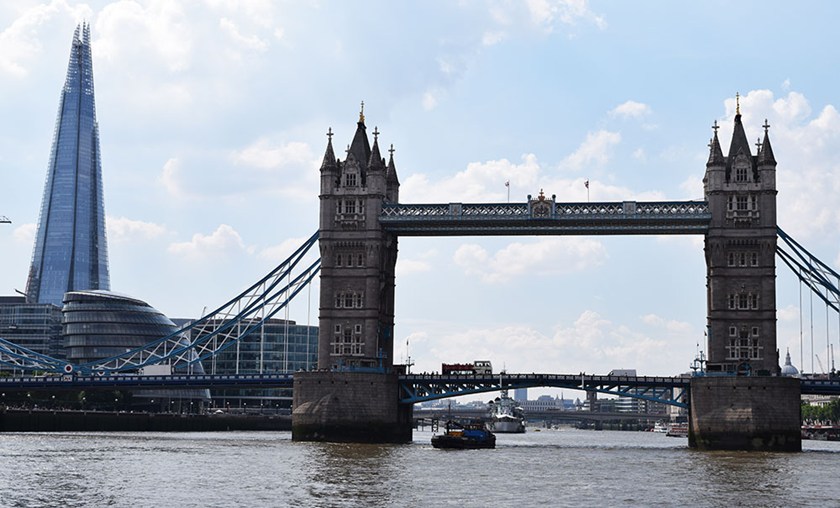
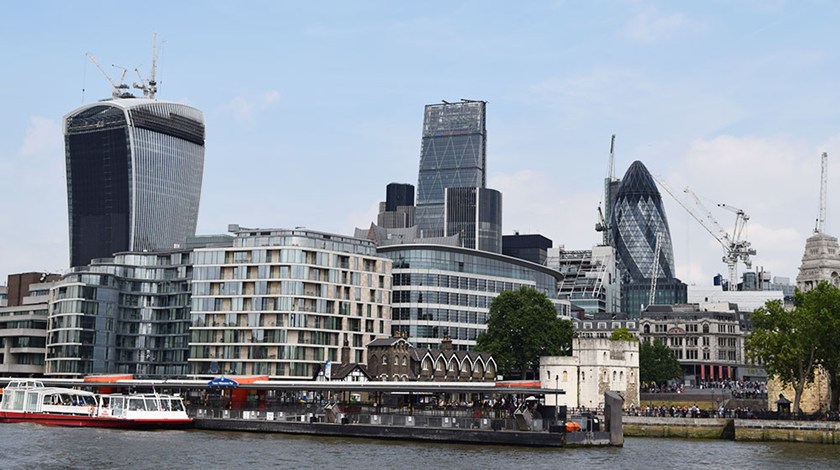
Above: You get a great view of new London on the trip down to Greenwich on the Thames River.
Soon we’re drifting in the direction of Greenwich and passing most of London’s great landmarks along the way – Big Ben, the London Eye, Shakespeare’s Globe Theatre, the Embankment, The Tower of London, the World War II relic HMS Belfast all pass slowly as our Cockney tour guide entertains us with some “naughty” city facts.
Old London looks so regal from the Thames but younger passengers appear more intrigued with the new, glittering skyline taking shape along both banks of the great river.
The bullet-shaped building known as the London Gherkin and the new egg-like Greater London Authority edifice where Mayor Boris Johnson has his office draw lots of camera attention, but it’s the new Shard that gets the most oohs and ahhs.
The 87-storey pyramid shaped Shard rises like a giant glass pencil on the shores of the Thames near Tower Bridge and is the now the largest building in the European Union.
After passing East London and the Canadian-inspired Canary Wharf office zone, we see the great domes of Greenwich’s historic Old Royal Naval College come into view and our pulse quickens at the prospect of what awaits in this city lost in time.
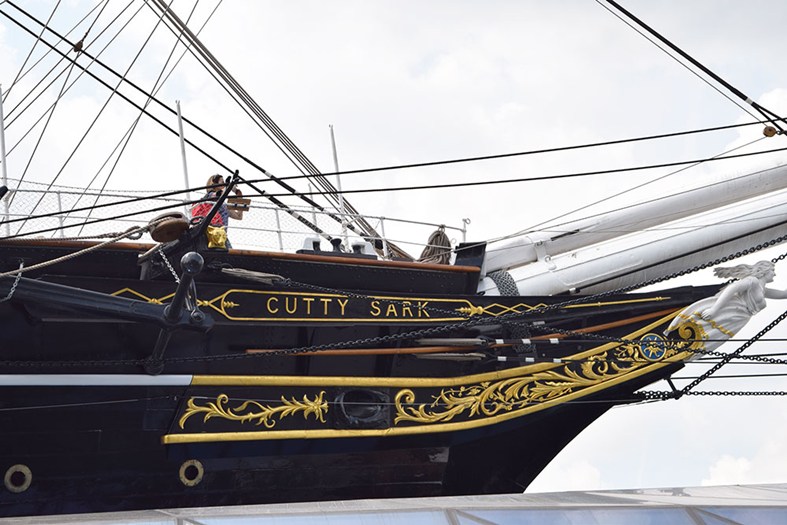
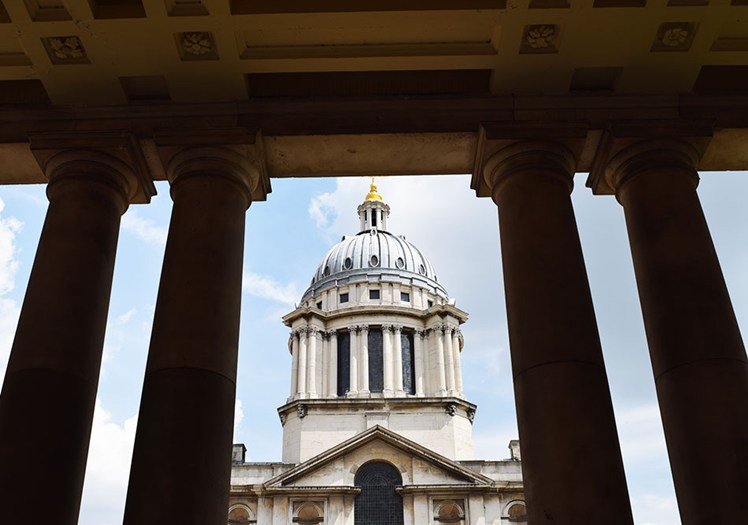
Above: A replica of the legendary Cutty Sark and some impressive buildings greet visitors to Greenwich.
History greets you as soon as we leave Greenwich’s busy pier – the renowned ship Cutty Sark sits dockside and is among one of the most visited attractions in this city that has produced some of England’s greatest naval heroes.
The 19th century Cutty Sark, the last surviving tea clipper ship which was designed to last 30 years but sailed the seas for nearly 80 years, has never looked better. Built in 1869, the Cutty Sark takes pride in being one of only three nationally registered ships anchored on the Thames (HMS Belfast and SS Robin) are the others.
She was recently raised three metres so visitors can walk under her huge hull which sailed on many oceans throughout a long and distinguished history.
School kids love running on the Cutty Sark’s wooden deck and are treated to lots of special attractions while onboard.
When a breeze rolls in off the Thames, some people say the Cutty Sark moves like it’s trying to break its anchor, jump back in the river and sail away again.
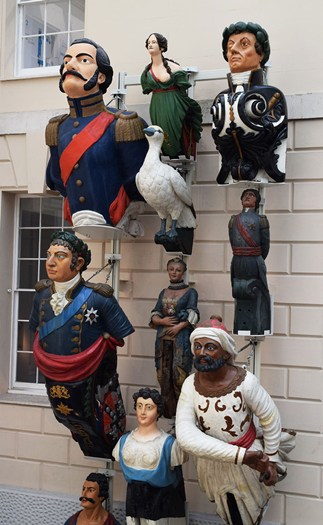
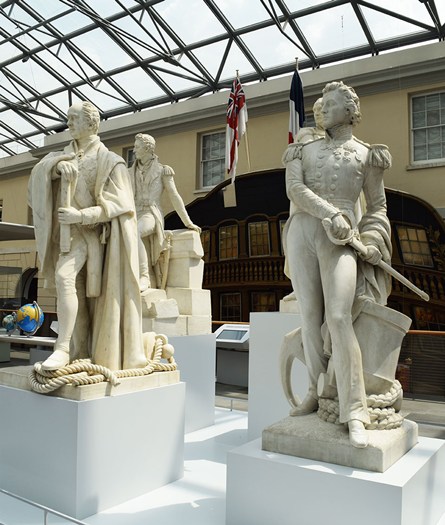
Above: Naval heroes are honoured in the main museum in Greenwich, which has some great relics.
The Cutty Sark is the perfect welcome to Greenwich, a town that became a popular resort destination for wealthy Londoners in the 18th century.
The town’s greatest claim to fame, though, came when a royal palace – the Palace of Placentia – was built here in the 15th century and became the vacation home of the House of Tudor. Both Henry VIII and Elizabeth I were born in the Greenwich palace, which was said to be Henry VIII’s favourite.
After falling into disrepair during the English Civil War, the palace was revived when the legendary architect Sir Christopher Wren remodelled it into a hospital for sailors. That’s when he added the great domes that now dominate the Greenwich skyline. The hospital became the Old Royal Naval College in 1873 and remained a site for military education until 1998 when it was turned over to a local trust.
Under one of the domes in the King William Court lies the Painted Hall, often described as the most beautiful dining hall in all of Europe. It ranks right up there with the Sistine Chapel in our humble opinion.
It took almost 20 years to complete the lavish paintings that adorn a hall originally intended as an eating place for retired sailors. After it was completed, however, it was deemed too grand for simple sailors and was used instead for major state occasions. This is where the body of naval hero Horatio Nelson lied in state after he was killed at the Battle of Trafalgar.
Visitors crane their necks looking at the great art work above them depicting some of Great Britain’s greatest naval triumphs and marvel at the marble floors and great columns that hold the domes in place.
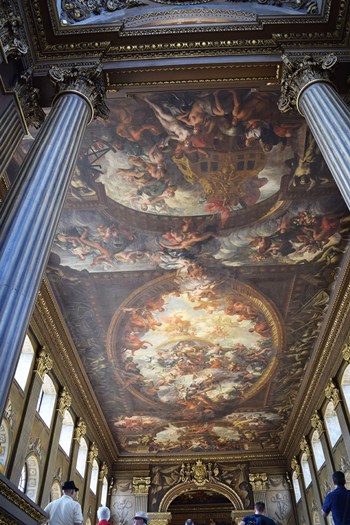
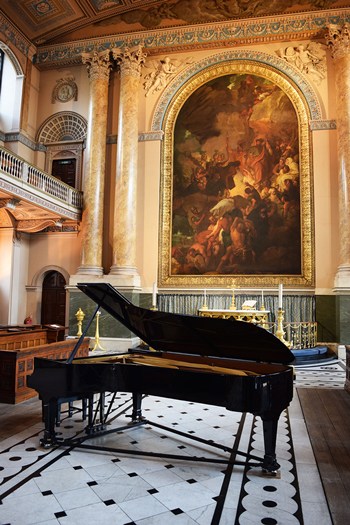
Above: The interiors of many Greenwich buildings remind us of England's glory days as a maritime power.
As marvellous as the Painted Hall is, we discover the Chapel in the opposite court – Queen Mary Court – to be just as fascinating although far less ornate. The Chapel was the last piece of the palace puzzle to be built but suffered major damage in a 1779 fire. It was redecorated in the Greek revival style it displays today and was dedicated to St. Peter and St. Paul because of their connections to water and the sea. The crowning touch in this chapel is the Benjamin West altarpieces that date back to the original building.
Our visit in enhanced by a mid-day piano recital. We’re in heaven as we listen to the music bounce off the walls of a chapel that has become one of the most sought after weeding venues in all of England.
There’s lots more to see and do on the grounds of the Old Royal Naval College: we throw 10 pence pieces down the brewery well and make a wish; admire the golden weather vanes atop the domes that are made of 200 sheets of gold leaf; watch kids try on some ancient armour and giggle when they find themselves trapped in the antique garb; salute the statue of George II that stands between the courts of King Charles and Queen Anne; and compare Wren’s magnificent domes with the ultra-modern Millennium Dome that sits directly across the Thames from Greenwich.
We could spend the entire day roaming the lovely palace but there’s still much more to see in Greenwich before catching our boat back to London. So we quickly wash down a plate of fish and chips with a pint of local beer in one of Greenwich’s historic pubs (this city is home to some of England’s oldest public houses) and then head to the National Maritime Museum to explore Great Britain’s marvellous naval history.
This museum is one of my favourite in all of Great Britain, a wonderful storehouse that chronicles this country’s great global sea adventures, from exploration to combat.
The most fascinating and visited of all the museum’s exhibits is the one dedicated to Admiral Lord Nelson, the hero of Trafalgar, whose victory and death in that great battle are honoured in a permanent gallery that’s filled with many Nelson mementoes, including his uniform complete with the bullet hole that felled him and the bloodstained clothes he was wearing on that fateful day.
But the gallery also gives visitors great insight into what life was like in Nelson’s era, when 18th century sailors were unwittingly “recruited” in local pubs and woke up in a drunken stupor onboard ships heading for the Far East or even worse, into battle.
More than 250 objects are on display in the Nelson Gallery and the old guns that once adorned Her Majesty’s great warships attract a lot of attention from the youngest visitors. I cringe at the sight of the primitive amputation knife used to hack off limbs of injured sailors.
The museum also delves into the checkered history of the infamous East India Company and its misadventures in Asia, including its role in the opium trade to China.
There are many interactive displays in the museum as well to keep young visitors entertained throughout their stay.
We just have time before our boat leaves for London to climb the steep hill behind the Maritime Museum and visit the Royal Observatory, which is best known as the location of the world’s prime meridian. The observatory has displays tracing its connection to astronomy and navigation and gives visitors a great view of the River Thames and East London. Canadians will find the statue of British General Wolfe, the conqueror of Quebec, which stands next to the observatory, most interesting.
As our cruise boat pulls away from Greenwich and the domes of the Old Naval College disappear, we celebrate our visit to this enchanting city with a glass of British ale, just like any good sailor would do.
Information
Admission to the museums in Greenwich and galleries like the Nelson are free but there is a charge for some special exhibits. / The National Maritime Museum, Royal Observatory and Old Naval College are open daily from 10 a.m. to 5 p.m. / Admission to the Cutty Sark is about $20 Cdn. for adults and $14 for children. For information go to
www.rmg.co.uk/cuttysark / For more information on Greenwich and its fabulous museums, go to
www.visitbritain.com / For cruise information, go to
www.thamesriverservices.co.uk / Air Canada, British Airways and a host of charter airlines offer daily flights to England from Toronto, Ottawa, Montreal, Calgary and Vancouver